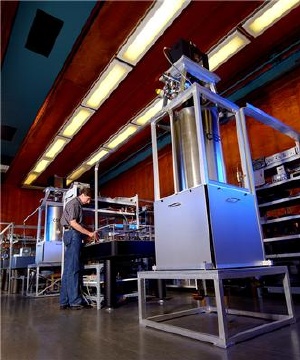Mar 18 2009
Caesium fountains are more accurate than "normal" atomic caesium clocks, because in fountains the caesium atoms are cooled down with the aid of laser beams and come ever slower - from a rapid velocity at room temperature to a slow "creep pace" of a few centimetres per second at a temperature close to the absolute zero point. Thus, the atoms remain together for a longer time so that the physicists have considerably more time to measure the decisive property of the caesium atoms which is required for the "generation of time": their resonance frequency. When a maximum of atoms has changed into an excited state, the frequency of the exciting signal is measured - those approximately nine billions of microwave oscillations which must elapse until exactly one second has past.
 The PTB caesium fountain clocks CSF1 and CSF2. (Credit: PTB)
The PTB caesium fountain clocks CSF1 and CSF2. (Credit: PTB)
The new technique no longer employs an oscillating quartz for microwave generation, but a microwave oscillator which can be excellently stabilized with the aid of extremely stable lasers. For this purpose, a so-called optical comb is used - a technique which has been developed for the establishment of optical atomic clocks. In the case of these atomic clocks, no microwave transitions, but optical transitions with frequencies five orders of magnitude above the microwave frequencies are used. For their well-aimed excitation, these transitions require extremely low-noise laser light which is generated with the aid of lasers which have been stabilized to special high-quality resonators. For measurement, the frequency of this laser light can be converted with the aid of the optical comb into microwave or low-frequency oscillations which finally allow the second pulses to be generated.
For use with a fountain, the microwave oscillator - which has been pre-stabilized by the highly stable laser and the optical comb - is slowly readjusted by the fountain output signal (like formerly the quartz oscillator). The results so far achieved show an improvement of the relative frequency instability by approximately 50% which leads to a reduction in the measurement times by a factor of 3.2. Instead of in three days, a measurement can then, for example, be performed in one day. The experiments show without a doubt that the microwave oscillator stabilized by the laser does no longer furnish any noise contribution so that the quantum projection noise limit has been reached. This noise is given by the quantum nature of the caesium atoms. This is caused by the fact that in clock operation, the atoms can never definitely change into the excited state, but that this always happens with a certain probability which leads to a noise contribution: the quantum projection noise.
The results clear the way for further improvements of the instability by increasing the atomic numbers used in the fountain clock. Improved instabilities are not only favourable as regards the required measurement times, but also allow systematic frequency-shifting effects to be investigated in closer detail. They are, therefore, also indispensable for future reductions in the overall uncertainty of the clock. This allows a fruitful interaction: while the fountains benefit from the technology of the optical clocks, the development of the latter benefits from the more exact fountain clock as an improved reference.
Source: Physikalisch-Technische Bundesanstalt (PTB)
Posted March 18th. 2009